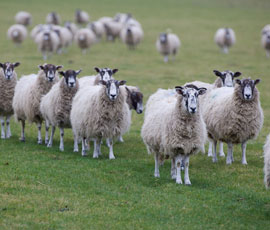Get ewe condition in shape now before tupping

Ewe body condition has been a problem for many farms in the last 18 months due to the weather and possibly the effect of liver fluke.
Now most lambs are weaned, it is the ideal time to manage ewe body condition so they are in optimum condition for tupping, according to EBLEX.
The target for ewes at weaning is generally a half or one body condition score (BCS) below the target for tupping, says Eblex livestock scientist Liz Genever. “It is worth noting that it takes six to eight weeks of unrestricted grazing (at a sward height of four to six centimetres) for ewes to gain one body condition score. Some producers will have proactively weaned ewes earlier than usual this season to ensure condition didn’t drop too much,” she says.
Hill ewes Upland ewes Lowland ewes
At weaning 2 2 2.5
At tupping 2.5 3 3.5
Mid-pregnancy 2 2.5 3
At lambing 2 2.5 3
The loss of one kilogram (kg) of liveweight releases about 17 Megajoules (MJ) of metabolisable energy (ME), while it takes about 65 MJ of ME to regain one kg. This is why ewes can lose condition very quickly, but take longer to recover.
Another way to think about it as that one BCS is about 10 per cent (%) of bodyweight, for example a 70kg ewe at BCS 3 would weigh about 63kg at BCS 2 and 77kg at BCS 4. So if a lowland ewe needs to average 74kg at tupping (about BCS 3.5) and is about 67kg at weaning (aboutBCS 2.5), she needs to gain 7kg. If she is weaned around 120 days before tupping, she needs to gain around 60g per day to achieve this.
The maintenance requirement for a 70kg ewe is 11 MJ of ME a day. An extra 3MJ per day is needed for that ewe to gain 50g per day, while if a gain of 100g per day is needed, the total ME requirement is 16.5MJ.
Dr Genever says at this time of year, there needs to be a balance between ewe requirements and managing pasture quality. “Dry ewes can be a useful tool to tidy up pastures and improve the quality for weaned lambs. Dry ewes in good condition can be restricted to 1.5 to 2% of bodyweight as dry matter (DM) intake per day (70 kg ewes = 1.1 to 1.4kg DM per day). Ewes that need to gain condition should not have intakes restricted and are likely to be eating more than 2.5% of their bodyweight (more than 1.8 kg DM per day,” she adds.
Grass with a high amount of green leaf and low levels of dead matter will have an ME of around 11.5 to 12MJ of ME per kg DM, whereas a grass sward made up of seed heads, stems and dead material may have a ME of eight to nine MJ per kg DM. It is still possible for ewes to gain weight on poorer pastures but they need to have unrestricted intakes, for example a daily intake of 1.8kg DM of grass at 8.5MJ of ME per kg DM equals around 15 MJ, which will allow the ewe to gain around 75g per day.
More information can be found in the manuals Target Ewe Fertility for Better Returns and Planning Grazing Strategies for Better Returns, which can be downloaded from the Better Returns Programme section .
More online
Get involved in the Farmers Weekly Stamp out Lameness in sheep campaign and be in with a chance of winning tickets to this year’s Farmers Weekly Awards.
